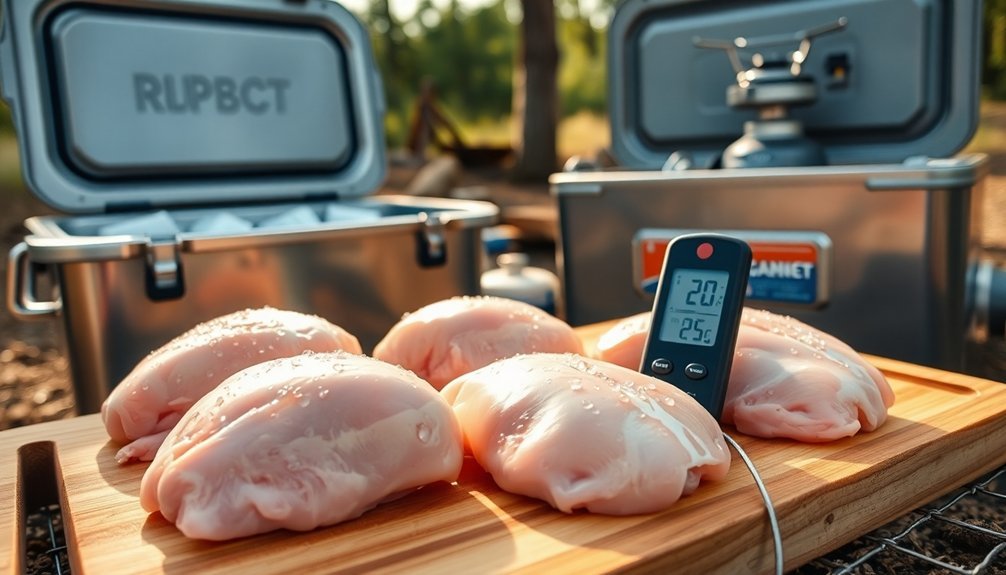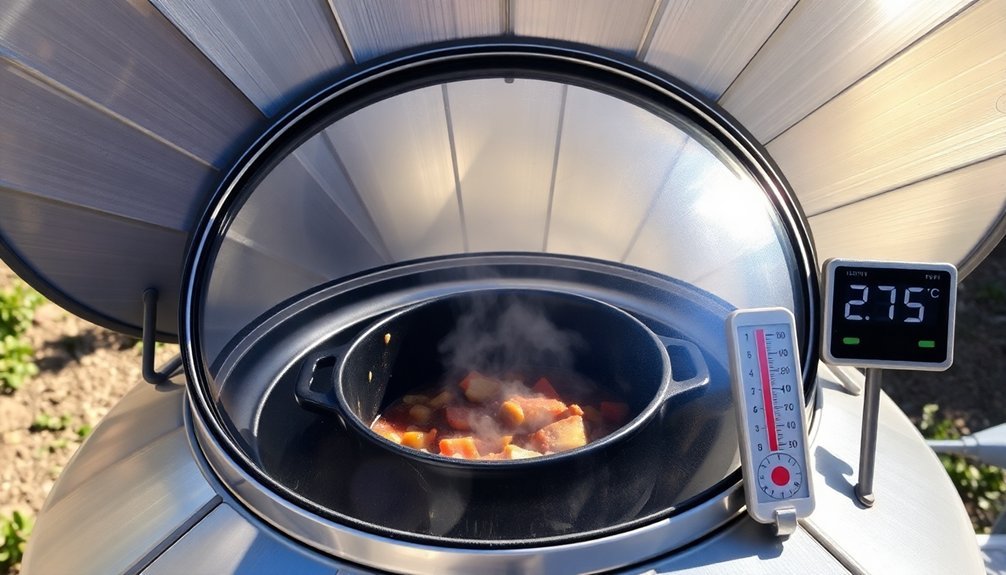When you cook with raw meat outdoors, you're facing several critical health risks that require careful attention. Raw meat can harbor dangerous bacteria like Salmonella and Campylobacter, which multiply rapidly between 40°F and 140°F – a temperature range your food can quickly enter during outdoor transport and preparation. You'll need to maintain strict temperature control, use separate utensils for raw and cooked foods, and guarantee proper storage in sealed containers to prevent cross-contamination. Without proper safety measures, you're putting yourself at risk for foodborne illness, but with the right knowledge and techniques, you can make outdoor cooking both safe and enjoyable.
Understanding Raw Meat Safety

When cooking outdoors, proper raw meat handling can mean the difference between a memorable barbecue and a food safety disaster.
You'll need to maintain raw meat at 40°F or below using coolers with ice packs during transport and storage. Don't let raw meat come into contact with ready-to-eat foods or beverages.
Store your raw meat in tightly sealed containers or bags to prevent juices from leaking. If you're working with frozen meat, make certain you thaw it properly in the refrigerator or cooler with ice.
Never leave raw meat at room temperature. When handling raw meat, you'll want separate cutting boards and utensils for raw and cooked foods to prevent cross-contamination. Discard any marinades after contact with raw meat to avoid potential foodborne illness.
Remember to clean your hands and all cooking tools thoroughly after they've touched raw meat.
Common Bacterial Threats
When you're grilling outdoors, you'll need to watch out for dangerous bacteria like Campylobacter and Salmonella that thrive in raw meat.
These harmful microorganisms can multiply rapidly between 40°F and 140°F, making temperature control essential during food preparation.
You'll also want to prevent cross-contamination by keeping raw meat separate from other foods and using different utensils for raw and cooked items. Always have soap and water available to maintain proper hand hygiene when handling raw meats during outdoor cooking.
Campylobacter and Salmonella Risks
Although outdoor cooking creates memorable experiences, two dangerous bacteria pose significant risks when handling raw meat: Campylobacter and Salmonella. You'll face higher risks during summer months, when these bacteria thrive. Both can lead to severe stomach cramps, vomiting, and diarrhea, with potentially life-threatening complications for children and elderly individuals. Recent studies show that 9.22 infections per serving occur during summer months with contaminated poultry.
| Risk Factor | Campylobacter | Salmonella |
|---|---|---|
| Main Source | Raw poultry | Poultry and beef |
| Peak Season | Summer months | Year-round |
| Transmission | Handling raw meat, contaminated water | Undercooked meat, cross-contamination |
| Prevention | Cook to 165°F (74°C) | Cook thoroughly |
| Risk Level | 27M+ infections in warm months | High in outdoor settings |
To protect yourself and your guests, always cook meat thoroughly and maintain proper food handling practices. Don't let these bacteria ruin your outdoor cooking experience.
Cross-Contamination Danger Zones
Building on the risks of Campylobacter and Salmonella, cross-contamination presents multiple danger zones in outdoor cooking environments.
When you're cooking outdoors, you'll face heightened risks from temperature fluctuations and limited access to proper sanitization.
The most critical danger zones you need to watch for include:
- Your hands and personal items – phones, towels, and aprons can transfer bacteria directly to food.
- Outdoor equipment and surfaces – cutting boards, utensils, and coolers need frequent sanitizing.
- Food handling practices – raw meat juices can contaminate other foods through improper storage or shared containers.
- Environmental factors – temperatures between 40°F and 140°F create ideal conditions for bacterial growth.
Don't let cross-contamination spoil your outdoor cooking experience.
Stay vigilant about separating raw meats, sanitizing surfaces, and maintaining proper food temperatures.
Temperature Control While Cooking

Maintaining proper temperature control while cooking outdoors can mean the difference between a safe meal and food poisoning. You'll need an instant-read digital thermometer to guarantee your meat reaches safe internal temperatures: 160°F for ground meats, 165°F for poultry, and varying temperatures for whole cuts based on desired doneness.
Always insert your thermometer into the thickest part of the meat, avoiding bone and fat that can give false readings. Remember that carryover cooking will increase temperatures by 5-10°F after you remove meat from heat.
Don't let your food linger in the danger zone between 40°F and 140°F, where bacteria thrive. If you're serving food over an extended period, use hot hold units to maintain temperatures above 140°F, guaranteeing everyone's safety throughout your outdoor gathering.
Proper Storage During Travel
You'll need to maintain strict temperature control when transporting raw meat by keeping it at or below 40°F in a pre-chilled, hard-sided cooler packed with ice.
Pack your cooler strategically by placing raw meat at the bottom, double-bagged to prevent leaks, and use a separate cooler for beverages to minimize lid openings.
Fill any empty spaces with ice and keep the cooler in the coolest part of your vehicle to guarantee safe temperatures throughout your journey.
Temperature Control While Moving
Safe transport of raw meat requires careful attention to temperature control during travel.
You'll need to maintain temperatures at 40°F or lower to prevent bacterial growth, especially during trips longer than 30 minutes. Pre-chill your cooler with ice for at least an hour before packing to guarantee ideal cold retention.
For effective temperature control while moving:
- Pack your cooler completely full, using frozen gel packs or drink bottles as additional cold sources.
- Double-bag raw meats and place them at the bottom of the cooler to prevent cross-contamination.
- Keep your cooler in a shaded spot, particularly when temperatures exceed 90°F.
- Monitor temperature upon arrival – ice should still be solid and meat should feel cool.
Cooler Organization Basics
Proper cooler organization forms the foundation of safe food transport during outdoor cooking trips.
You'll need to start by pre-chilling your cooler with ice several hours before packing and creating a solid ice base layer of 1-2 inches at the bottom.
Keep raw meats in sealed containers at the cooler's base to prevent cross-contamination with other foods.
You'll want to pack twice as much ice as food, filling all empty spaces to eliminate air pockets.
If you're planning multiple meals, organize your cooler in sections and pack in reverse order of use, except for raw meat which stays at the bottom.
For longer trips, you're better off using two separate coolers – one for food and another for drinks.
This strategy helps maintain colder temperatures and reduces the frequency of opening your food cooler.
Safe Handling Techniques

When handling raw meat outdoors, following strict safety protocols prevents foodborne illness and cross-contamination.
You'll need to maintain proper hygiene and separate raw meats from other foods throughout your outdoor cooking experience.
- Always wash your hands with soap and water before and after touching raw meat, and keep clean towelettes handy when water isn't accessible.
- Use separate cutting boards and utensils for raw meat to prevent cross-contamination with other foods.
- Store marinades in the refrigerator or cooler, and never reuse marinades that have touched raw meat.
- Clean all surfaces, platters, and utensils that contact raw meat with hot, soapy water, then sanitize with a bleach solution (¾ teaspoon per quart of water).
Remember to keep raw meat juices away from ready-to-eat foods, and maintain strict separation during storage and preparation.
Cross-Contamination Prevention Methods
When you're cooking outdoors with raw meat, you'll need dedicated tools and surfaces for raw and cooked foods to prevent dangerous cross-contamination.
Your storage practices should include keeping raw meats sealed and separated from other foods, while maintaining proper temperature control in coolers and containers.
Always clean and sanitize your hands, utensils, and cooking surfaces before and after handling raw meats to guarantee safe food preparation.
Separate Tools and Surfaces
Maintaining separate tools and surfaces stands as an essential defense against foodborne illness during outdoor cooking.
You'll need to be vigilant about keeping raw and cooked foods completely separate throughout your grilling process. Use dedicated plates and utensils for raw meats, and never reuse them for cooked foods without thorough cleaning.
- Keep two sets of tongs and spatulas – one for raw meat handling and another for cooked foods
- Replace worn cutting boards that have deep scratches where bacteria can hide
- Clean all surfaces with hot soapy water immediately after contact with raw meat
- Use paper towels instead of cloth towels to prevent bacterial spread
Remember to sanitize your grill and work areas according to manufacturer guidelines, and always use clean serving trays between different food items to maintain safe food handling practices.
Safe Storage Practices
Proper storage practices serve as your first line of defense against cross-contamination during outdoor cooking.
Keep raw meat in leak-proof containers within insulated coolers, and always place them at the bottom to prevent juices from dripping onto other foods. You'll want to maintain temperatures below 40°F by using plenty of ice or ice packs.
Don't forget to store your coolers in shaded areas or cover them with blankets for extra insulation. When transporting food, place the cooler on your car's floor away from sunlight.
Keep a separate cooler for beverages to guarantee your drink ice stays clean and safe. Remember to discard any perishable foods left in the danger zone for more than two hours, or just one hour if temperatures exceed 90°F.
Clean and Sanitize Always
Effective sanitization serves as the cornerstone of safe outdoor cooking, especially when handling raw meat.
You'll need to be vigilant about keeping everything clean and sanitized to prevent cross-contamination that could make you sick.
Follow these essential steps to maintain a safe cooking environment:
- Wash your hands with warm, soapy water for at least 20 seconds before and after handling raw meat – use hand sanitizer if soap isn't available.
- Use separate cutting boards and utensils for raw meat and ready-to-eat foods, never mixing them without proper cleaning.
- Sanitize all food contact surfaces with hot, soapy water and bleach after they've touched raw meat.
- Don't reuse marinades or sauces that have touched raw meat, and keep raw meat juices away from other foods during transport and preparation.
Essential Safety Equipment

Safe outdoor cooking demands specific equipment to protect against foodborne illness and cross-contamination.
You'll need separate platters and utensils for raw and cooked meats, along with long-handled tongs to handle food without piercing it. A reliable food thermometer is essential to guarantee your meat reaches safe internal temperatures: 165°F for poultry, 160°F for ground meats, and 145°F for steaks and fish.
Don't forget to pack clean, soapy sponges and wet towelettes for sanitizing surfaces and hands. Your utensils must be made of food-grade materials approved for meat contact.
Keep multiple sets of tongs handy, or thoroughly wash them between handling raw and cooked foods. Store these tools in a clean, designated area to prevent contamination and guarantee they're readily available when you need them.
Marinating Guidelines for Outdoor Cooking
When marinating meat for outdoor cooking, understanding the ideal timing and ingredients can transform your grilling results.
You'll need to respect specific time limits: seafood needs just 30 minutes, while tough beef cuts require 24 hours or more. Always marinate in your refrigerator using food-safe containers to prevent bacterial growth.
For the perfect marinade, combine these essential elements:
- A base of acid (vinegar, citrus, or wine) to tenderize
- Oil (olive, canola, or sesame) to maintain moisture
- Salt or salty liquid to enhance flavor absorption
- Sweetener like honey to promote caramelization
Don't forget to pierce your meat with a fork before marinating, and pat it dry before it hits the grill.
Never reuse marinade that's touched raw meat unless you've boiled it first.
Best Practices for Solar Cooking

Understanding solar cooking requires mastering the right equipment and setup techniques.
You'll need dark-colored cookware, preferably Granite Ware pots with lids, to absorb and retain heat efficiently. Avoid light or shiny containers unless you cover them with dark material.
Position your solar oven facing south and preheat it for 15-20 minutes before cooking. The interior temperature must reach at least 180°F for safe meat preparation. Keep cooked food above 125°F or below 50°F to prevent bacterial growth. Monitor temperatures using a thermometer and set timers to avoid overcooking.
Remember to adjust the reflectors' angle and periodically move the cooker to follow the sun. Line cooking trays for easy cleanup, and always use pot-holders when handling the preheated oven.
Discard any food showing signs of spoilage.
Alternative Cooking Methods
Outdoor cooking offers several reliable alternatives beyond traditional grilling, each with unique advantages for preparing meals in nature.
You'll find these methods particularly useful when handling raw meat, as they provide consistent heat and controlled cooking environments.
- Try a rocket stove for its efficient J-shaped design that creates intense heat with minimal fuel, making it perfect for quick-cooking meat dishes.
- Consider a pit oven for slow-cooking large cuts, where food wrapped in foil cooks evenly surrounded by hot coals.
- Use a Swedish fire log as your portable cooking platform, especially effective in wet conditions.
- Experiment with solar ovens that can reach up to 400 degrees on sunny days, offering a sustainable way to safely cook meat without fuel.
These alternatives guarantee your meat reaches safe temperatures while preserving flavor and nutrients.
Checking for Doneness

Determining if your meat is properly cooked can mean the difference between a delicious meal and a food safety risk.
You'll get the most accurate results using a meat thermometer inserted into the thickest part of the cut. Wait 45 seconds for a stable reading, and remove your meat when it's 5°F below your target temperature, as it'll continue cooking during rest.
While you might be tempted to rely on the finger test, comparing meat firmness to your palm's tension, it's not as reliable as a thermometer.
For food safety, verify whole cuts reach 145°F, ground meats hit 160°F, and poultry reaches 165°F.
Let your meat rest for three minutes after cooking.
Don't trust color or texture alone – they're not reliable indicators of doneness.
Safe Meat Transportation Tips
Once you've confirmed your meat is properly cooked, the next challenge is getting it to your outdoor destination safely.
You'll need to maintain proper temperature control and prevent cross-contamination during transport to keep your food safe for consumption.
For safe meat transportation, follow these essential tips:
- Pre-cool your coolers and use hard-sided ice packs to maintain temperatures at 40°F or below for raw meat, or 140°F and above for cooked foods.
- Pack raw meats in sealed containers at the bottom of the cooler, or better yet, use separate coolers for raw and cooked items.
- Fill coolers completely, as fully packed coolers maintain temperature better than partially filled ones.
- Keep transport time as brief as possible, and protect food from environmental contaminants during loading and unloading.
Frequently Asked Questions
Can Wild Game Meat Be Safely Cooked Over a Campfire?
Yes, you can safely cook wild game over a campfire if you'll use a meat thermometer to guarantee proper internal temperatures: 165°F for most game, monitor your fire's heat, and check that meat juices run clear.
How Does Altitude Affect Cooking Times for Raw Meat Outdoors?
At higher altitudes, you'll need up to 25% more cooking time since water boils at lower temperatures. Your meat will dry out faster too, so keep it covered and use a meat thermometer for safety.
Which Types of Wood Should Be Avoided When Smoking Meat?
You'll need to avoid softwoods like pine and cedar, toxic woods like mangrove and yew, chemically treated lumber, and moldy or unidentified wood. These can release harmful toxins into your meat.
Do Solar Ovens Effectively Kill Bacteria in Raw Meat?
Yes, your solar oven will effectively kill bacteria in raw meat when it reaches 180-250°F (82-121°C). You'll need to add an extra hour to normal cooking times for thorough bacterial elimination.
Can Raw Meat Be Safely Cooked in Survival Situations Without Tools?
You can safely cook raw meat without tools by using hot rocks, fire spits, or earth ovens. Confirm it's thoroughly cooked by checking color, texture, and juices. Don't eat meat that's still pink inside.
In Summary
Don't risk your health by mishandling raw meat during outdoor cooking. You'll need to maintain proper temperatures, use clean equipment, and follow safe storage practices from start to finish. Whether you're grilling, smoking, or solar cooking, make certain you're checking meat doneness with a thermometer. By following these safety guidelines, you'll keep harmful bacteria at bay and guarantee everyone enjoys a safe outdoor meal.





Leave a Reply